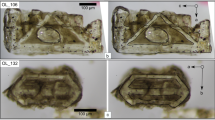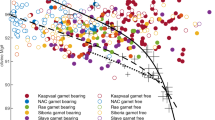Abstract
OLIVINE, α-(Mg,Fe)2SiO4, is the most abundant phase in the Earth's upper mantle. It transforms to high-density polymorphs (α, with the spinel structure and β, with a modified spinel structure) under pressure and temperature conditions appropriate to explain the discontinuity in seismic velocities that defines the base of the upper mantle at 400km depth; the transformation is generally believed to be responsible for that discontinuity1. Knowledge of the mechanism and kinetics of the transformation is important for understanding certain aspects of mantle dynamics, and extensive experimental and theoretical work has been conducted on both natural olivine and several analogous chemical systems. Previously, conflicting results have suggested a reconstructive transformation mechanism2–10, a martensitic mechanism11, 12 and a mechanism that is not entirely consistent with either13–16. The conflicts cannot be explained as different mechanisms operating in different systems17. Here we show that the transformation can proceed by two different mechanisms, depending on the level of nonhydrostatic stress; under hydrostatic pressure or low stresses (at sufficiently high temperatures), nucleation occurs by an incoherent, diffusion-dependent, intercrystalline mechanism proposed by Sung and Burns2, 3 and first demonstrated by Vaughan et al.4 (Fig. 1), whereas under high stresses, nucleation of the high-pressure (γ) polymorph (spinel) occurs by a coherent, shear-induced, intracrystalline mechanism predicted by Poirier18. Thus we are able to reconcile the previously conflicting results, and consideration of the stress levels likely in natural situations leads us to conclude that both mechanisms are geologically relevant.
This is a preview of subscription content, access via your institution
Access options
Subscribe to this journal
Receive 51 print issues and online access
$199.00 per year
only $3.90 per issue
Buy this article
- Purchase on Springer Link
- Instant access to full article PDF
Prices may be subject to local taxes which are calculated during checkout
Similar content being viewed by others
References
Bina, C. R. & Wood, B. J. Nature 324, 449–451 (1986).
Sung, C. & Burns, R. G. Tectonophysics 31, 1–32 (1976).
Sung, C. & Burns, R. G. Earth planet. Sci. Lett. 32, 165–170 (1976).
Vaughan, P. J., Green, H. W. & Coe, R. S. Nature 298, 357–358 (1982).
Boland, J. N. & Liebermann, R. C. Geophys. Res. Lett. 10, 87–90 (1983).
Rubie, D. C., Tsuchida, Y., Utsumi, W., Kikegawa, T., Shimomura, O. & Yagi, T. 28th High Pressure Conference of Japan 132–133 (1987).
Yagi, T., Akaogi, M., Shimamura, O., Suzuki, T. & Akimoto, S. J. geophys. Res. 92, 6207–6213 (1987).
Remsberg, A. R., Boland, J. N., Gasparik, T. & Liebermann, R. C. Phys. chem. Miner. 15, 498–506 (1988).
Vaughan, P. J., Green, H. W. & Coe, R. S. Tectonophysics 108, 299–322 (1984).
Rubie, D. C. & Champness, P. E. Bull. Miner. 110, 471–480 (1987).
Lacam, A., Madon, M. & Poirier, J.-P. Nature 228, 155–157 (1980).
Boland, J. N. & Liu, L. Nature 303, 233–235 (1983).
Hamaya, N. & Akimoto, S. in High Pressure Research in Geophysics (eds Akimoto, S. & Manghnani, M. E.) 373–389 (Center Academic, Tokyo, 1982).
Hamaya, N. & Akimoto, S. Phys. Earth Planet. Inter. 29, 6–11 (1982).
Furnish, M. D. & Bassett, W. A. J. geophys. Res. 88, 333–342 (1983).
Will, G. & Lauterjung, J. in High Pressure Research in Mineral Physics (eds Manghnani, M. H. & Syono, Y.) Geophys. Monogr. 39, 177–186 (American Geophysical Union, Washington, DC, 1987).
Green, H. W., Geophys. Res. Lett. 11, 817–820 (1984).
Poirier, J.-P. in Anelastic Properties and Related Process in the Earth's Mantle Geodyn. Ser. 4, 113–117 (American Geophysical Union, Washington, DC, 1981).
Burnley, P. C. & Green, H. W. Eos 69, 1416–1417 (1988).
Green, H. W. Geophys. Mongr. 36, 201–211 (1986).
Burnley, P. C. & Green, H. W. Eos 68, 1471 (1987).
Green, H. W. & Borch, R. S. Eur. J. Miner. (in the press).
Webb, S. L., Jackson, I. & Takei, H. Phys. Chem. Miner. 11, 167–171 (1984).
Hornstra, J. J. phys. Chem. Solids 15, 311–323 (1960).
Remsberg, A. R., Boland, J. N., Gasparik, T. & Liebermann, R. C. Eos 68, 1539 (1987).
Putnis, A. & Price, G. D. Nature 280, 217–218 (1979).
Price, G. C., Putnis, A. & Agrell, S. O. Contrib. Miner. Petrol. 71, 211–218 (1979).
Price, G. D., Putnis, A. & Smith, D. G. W. Nature 296, 729–730 (1982).
Author information
Authors and Affiliations
Rights and permissions
About this article
Cite this article
Burnley, P., Green, H. Stress dependence of the mechanism of the olivine–spinel transformation. Nature 338, 753–756 (1989). https://doi.org/10.1038/338753a0
Received:
Accepted:
Issue Date:
DOI: https://doi.org/10.1038/338753a0
This article is cited by
-
Detection of thin film phase transformations at high-pressure and high-temperature in a diamond anvil cell
Communications Earth & Environment (2024)
-
In situ observation of coalescence of nuclei in colloidal crystal-crystal transitions
Nature Communications (2023)
-
Resolving puzzles of the phase-transformation-based mechanism of the strong deep-focus earthquake
Nature Communications (2022)
-
Poirierite, a dense metastable polymorph of magnesium iron silicate in shocked meteorites
Communications Earth & Environment (2021)
-
A unifying basis for the interplay of stress and chemical processes in the Earth: support from diverse experiments
Contributions to Mineralogy and Petrology (2020)
Comments
By submitting a comment you agree to abide by our Terms and Community Guidelines. If you find something abusive or that does not comply with our terms or guidelines please flag it as inappropriate.



